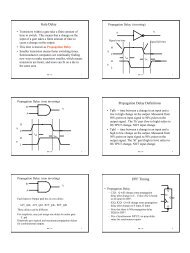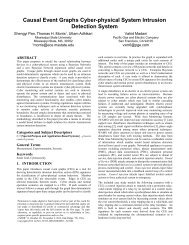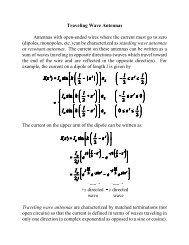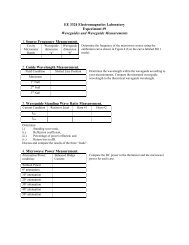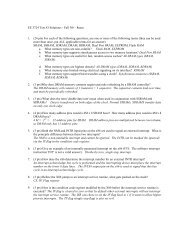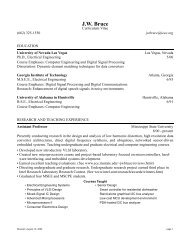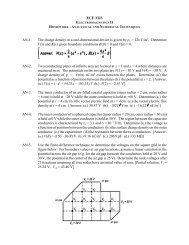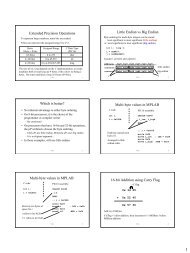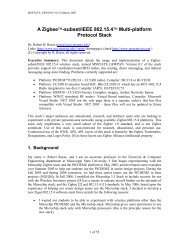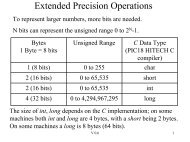Boolean Algebra Boolean Variables, Functions NOT operation AND ...
Boolean Algebra Boolean Variables, Functions NOT operation AND ...
Boolean Algebra Boolean Variables, Functions NOT operation AND ...
Create successful ePaper yourself
Turn your PDF publications into a flip-book with our unique Google optimized e-Paper software.
<strong>Boolean</strong> <strong>Algebra</strong><br />
• Basic mathematics for the study of logic design is<br />
<strong>Boolean</strong> <strong>Algebra</strong><br />
• Basic laws of <strong>Boolean</strong> <strong>Algebra</strong> will be<br />
implemented as switching devices called logic<br />
gates.<br />
• Networks of Logic gates allow us to manipulate<br />
digital signals<br />
– Can perform numerical <strong>operation</strong>s on digital signals<br />
such as addition, multiplication<br />
– Can perform translations from one binary code to<br />
another.<br />
BR 8/99 1<br />
<strong>Boolean</strong> <strong>Variables</strong>, <strong>Functions</strong><br />
• A boolean variable can take on two values<br />
– Will use the values ‘0’ and ‘1’<br />
– Could just as easily use ‘T’, ‘F or H,L or ON,OFF<br />
• <strong>Boolean</strong> <strong>operation</strong>s transform <strong>Boolean</strong> <strong>Variables</strong>.<br />
– Basic <strong>operation</strong>s are <strong>NOT</strong>, <strong>AND</strong>, OR<br />
• We can make more complicated <strong>Boolean</strong><br />
<strong>Functions</strong> from the basic boolean <strong>operation</strong>s<br />
BR 8/99 2<br />
Truth Table<br />
A Y<br />
0 1<br />
1 0<br />
<strong>NOT</strong> <strong>operation</strong><br />
The <strong>NOT</strong> <strong>operation</strong> (or inverse, or complement <strong>operation</strong>) replaces a<br />
boolean value with its complement:<br />
0’ = 1 , 1’ = 0<br />
A’ is read as <strong>NOT</strong> A or Complement A<br />
F(A) = A’<br />
A A’<br />
Inverter symbol<br />
boolean representation<br />
BR 8/99 3<br />
<strong>AND</strong> <strong>operation</strong><br />
The <strong>AND</strong> <strong>operation</strong> is a function of two variables (A, B)<br />
F(A,B) = A • B boolean function representation<br />
When both A and B are ‘1’, then F is ‘1’.<br />
0 • 0 = 0, 0 • 1 = 0, 1 • 0 = 0, 1 • 1 = 1<br />
Truth Table<br />
A B Y<br />
0 0 0<br />
0 1 0<br />
1 0 0<br />
1 1 1<br />
A<br />
B<br />
<strong>AND</strong><br />
F<br />
BR 8/99 4<br />
<strong>AND</strong> <strong>operation</strong> (cont).<br />
Will usually drop the ‘• ‘ in the equation and just write the equation<br />
as:<br />
F(A,B) = AB boolean function representation<br />
Can also view <strong>AND</strong> <strong>operation</strong> as two switches in series:<br />
Switch Open (0)<br />
Switch Closed (1)<br />
A B When Switch A closed (1)<br />
and Switch B closed (1),<br />
circuit is closed (1)<br />
BR 8/99 5<br />
OR <strong>operation</strong><br />
The OR <strong>operation</strong> is a function of two variables (A, B)<br />
F(A,B) = A + B boolean function representation<br />
When either A or B are ‘1’, then F is ‘1’.<br />
0 + 0 = 0, 0 + 1 = 1, 1 + 0 = 1, 1 + 1 = 1<br />
Truth Table<br />
A B Y<br />
0 0 0<br />
0 1 1<br />
1 0 1<br />
1 1 1<br />
OR<br />
BR 8/99 6
OR <strong>operation</strong> (cont).<br />
Can view OR <strong>operation</strong> as two switches in parallel:<br />
A<br />
Neither switch A or switch B is<br />
B<br />
closed, so circuit is open (0)<br />
A<br />
B<br />
Switch B closed (1), so circuit is<br />
closed (1)<br />
<strong>Boolean</strong> <strong>Functions</strong><br />
More complex boolean functions can be created by combining<br />
basic <strong>operation</strong>s<br />
A A’<br />
F(A,B) = A’ + B<br />
B<br />
OR<br />
A<br />
B<br />
A<br />
B<br />
Switch A closed (1), so circuit is<br />
closed (1)<br />
Switch A or Switch B is closed,<br />
circuit is closed (1)<br />
BR 8/99 7<br />
A B A’ F = A’ + B<br />
0 0 1 1<br />
0 1 1 1<br />
1 0 0 0<br />
1 1 0 1<br />
BR 8/99 8<br />
Basic Theorems<br />
Duality<br />
X + 0 = X<br />
X + 1 = 1<br />
X + X = X<br />
(X’)’ = X<br />
Duals<br />
X * 1 = X<br />
X * 0 = 0<br />
X * X = X<br />
(X’)’ = X<br />
X + X’ = 1 X * X’ = 0<br />
A dual of a boolean expression is formed by replacing<br />
<strong>AND</strong>s with ORs, ORs with <strong>AND</strong>s, ‘1’s with ‘0’s, and<br />
‘0’s with ‘1’s. <strong>Variables</strong> and their complements are left<br />
alone.<br />
If two boolean expressions are equal, then their duals are<br />
equal!<br />
Helpful in remembering boolean laws. Only need to<br />
remember one set, can generate the 2nd set by taking the<br />
dual!<br />
BR 8/99 9<br />
BR 8/99 10<br />
Proving a Theorem<br />
How do we prove X + 0 = X is correct<br />
One way is to replace all boolean variables with values of ‘0’, ‘1’<br />
and use basic <strong>operation</strong>s:<br />
For X = 0, 0 + 0 = 0 For X = 1, 1 + 0 = 1<br />
0 = 0 1 = 1<br />
So, X + 0 = X is valid.<br />
Prove X + X’ = 1<br />
For X = 0, 0 + (0)’ = 1 For X = 1, 1 + (1)’ = 1<br />
0 + 1 = 1 1 + 0 = 1<br />
1 = 1 1 = 1<br />
So, X + X’ = 1 is valid.<br />
BR 8/99 11<br />
Commutative, Associative Laws<br />
Commutative<br />
X + Y = Y + X<br />
Associative<br />
(X + Y) + Z = X + (Y + Z)<br />
Dual Laws<br />
X * Y = Y * X<br />
Associative<br />
(XY) Z = X(YZ)<br />
If ‘+’ is viewed as addition, and ‘*’ as multiplication, then the<br />
Commutative, Associative laws in normal algebra are the same as<br />
in boolean algebra.<br />
BR 8/99 12
A<br />
B<br />
C<br />
Three Input <strong>AND</strong> Function<br />
F = ABC = (AB) C = A (BC)<br />
A B C AB F = ABC<br />
0 0 0 0 0<br />
0 0 1 0 0<br />
0 1 0 0 0<br />
0 1 1 0 0<br />
1 0 0 0 0<br />
1 0 1 0 0<br />
1 1 0 1 0<br />
1 1 1 1 1<br />
A(B + C) = AB + AC<br />
Distributive Law<br />
(valid in normal algebra)<br />
Dual:<br />
A + BC = (A + B) (A + C) (only valid in <strong>Boolean</strong> algebra!)<br />
Note that the 2nd form is <strong>NOT</strong> valid in normal algebra! This<br />
tends to make one forget about it. Remember the first form,<br />
then take the DUAL of it to get the second form.<br />
BR 8/99 13<br />
BR 8/99 14<br />
Prove A + BC = (A + B) (A + C)<br />
Use Truth Table method for both sides<br />
A B C BC A+BC A+B A+C (A+B)(A+C)<br />
0 0 0 0 0 0 0 0<br />
0 0 1 0 0 0 1 0<br />
0 1 0 0 0 1 0 0<br />
0 1 1 1 1 1 1 1<br />
1 0 0 0 1 1 1 1<br />
1 0 1 0 1 1 1 1<br />
1 1 0 0 1 1 1 1<br />
1 1 1 1 1 1 1 1<br />
Other Simplification Theorems<br />
Duals<br />
XY + XY’ = X<br />
(X +Y)(X+Y’) = X<br />
X + XY = X<br />
X(X + Y) = X<br />
(X + Y’)Y = XY<br />
XY’ + Y = X + Y<br />
Prove XY + XY’ = X via algebraic manipulation<br />
XY + XY’ = X (Y + Y’) = X (1) = X !!!!!<br />
Results are same<br />
BR 8/99 15<br />
BR 8/99 16<br />
Simplification<br />
• Simplification tries to reduce the number of terms in a<br />
boolean equation via use of basic theorems<br />
• A simpler equation will mean:<br />
– less gates will be needed to implement the equation<br />
– could possibly mean a faster gate-level implementation<br />
• Will use algebraic techniques at first for simplification<br />
– Later, will use a graphical method called K-maps<br />
– Computer methods for simplification are widely used in industry.<br />
Sum Of Products (SOP) Form<br />
A boolean expression is in Sum Of Products form when all<br />
products are the products of single variables only.<br />
F = AB’ + CD’E + AC’E’ (SOP Form)<br />
G = ABC’ + DEFG + H (SOP Form)<br />
Y = A + B’ + C + D<br />
(SOP Form)<br />
Z = (A+B)CD + EF Not SOP Form<br />
= ACD + BCD + EF SOP Form<br />
BR 8/99 17<br />
BR 8/99 18
Use Distributive Law for Multiplying<br />
Problem: Put into SOP form the following equation and<br />
simplify:<br />
(A + BC) (A + D + E)<br />
Try just straightforward multiplication of terms:<br />
AA + AD + AE + ABC + BCD + BCE<br />
Simplify (AA = A):<br />
A + AD + AE + ABC + BCD + BCE<br />
Look for simplification via factoring:<br />
A(1 + D + E + BC) + BCD + BCE<br />
A (1) + BCD + BCE<br />
A+ BCD + BCE !!!!!!!!! (Final SOP form)<br />
BR 8/99 19<br />
Use 2nd Distributive Law<br />
Recall 2nd Distributive Law:<br />
(X + Y)(X + Z) = X + YZ<br />
Lets try and use this law, may make things easier:<br />
(A + BC) (A + D + E)<br />
(A + (BC)) ( A + (D + E) )<br />
Apply 2nd Distributive Law:<br />
A + BC (D + E)<br />
Multiply Out:<br />
A + BCD + BCE (Final SOP form)<br />
Finished!!<br />
BR 8/99 20<br />
B<br />
C<br />
D<br />
B<br />
C<br />
E<br />
A + BCD + BCE as logic gates<br />
A<br />
<strong>AND</strong>-OR form<br />
SOP can be implemented in two levels of logic assuming<br />
that both a variable (A) and its complement (A’) are<br />
available (Dual Rail Inputs). SOP is a TWO-LEVEL form<br />
(<strong>AND</strong>-OR)<br />
BR 8/99 21<br />
Product of Sums (POS) Form<br />
A boolean expression is in Product Of Sums form when all<br />
sums are the sums of single variables.<br />
F = (A + B’)(C + D’ + E)(A + C’ + E’)<br />
G = A (B + E)(C + D) (POS Form)<br />
Y = AB + AC Not POS Form<br />
= A (B + C) POS Form<br />
(POS Form)<br />
BR 8/99 22<br />
Factoring<br />
Use factoring to get to Product of Sums form.<br />
Use basic theorem:<br />
X + YZ = (X + Y) (X + Z) (just reverse of distributive law)<br />
Problem: Put A + B’CD into POS Form:<br />
A + B’CD = (A + B’) (A + CD )<br />
= (A + B’) (A + C) (A + D)<br />
(A + B’) (A + C) (A + D) is final POS form!!!!<br />
BR 8/99 23<br />
(A+B’)(A+C)(A+D) as Logic Gates<br />
A<br />
B’<br />
A<br />
C<br />
A<br />
D<br />
OR-<strong>AND</strong> form<br />
POS can be implemented in two levels of logic assuming<br />
that both a variable (A) and its complement (A’) are<br />
available (Dual Rail Inputs). POS is a TWO-LEVEL form<br />
(OR-<strong>AND</strong> form)<br />
BR 8/99 24
Consensus Theorem<br />
Consensus theorem states:<br />
XY + X’Z + YZ = XY + X’Z<br />
The YZ term is called the consensus term and is<br />
redundant. The consensus term is formed from a PAIR<br />
OF TERMS in which a variable (X) and its complement<br />
(X’) are present; the consensus term is formed by<br />
multiplying the two terms and leaving out the selected<br />
variable and its complement.<br />
Prove the Consensus Theorem<br />
Consensus Theorem Proof:<br />
XY + X’Z + YZ = XY + X’Z + (X + X’)YZ<br />
= XY + X’Z + XYZ + X’YZ<br />
= (XY + XYZ) + (X’Z + X’YZ)<br />
= XY (1 + Z) + X’Z (1 + Y)<br />
= XY + X’Z<br />
You could also use a truth table to prove this.<br />
The consensus of XY, X’Z is YZ .<br />
BR 8/99 25<br />
BR 8/99 26<br />
Dual of the Consensus Theorem<br />
(X+Y) (X’ + Z) (Y + Z) = (X + Y) (X’ + Z)<br />
Short Cuts for Multiplying<br />
A short cut theorem for Distribution (Multiplication)<br />
(X + Y) (X’ + Z) = XZ + X’Y<br />
The consensus of (X+Y)(X’+Z) is (Y + Z) .<br />
How do you use the consensus theorem Simply be<br />
suspicious anytime you have two terms that have a variable<br />
and its complement. Form the consensus term and see if it is<br />
present; if consensus term is present, just get rid of it.<br />
BR 8/99 27<br />
Only works when you have a variable (X) and its complement<br />
(X’). To PROVE this, lets do the distribution the long way.<br />
(X + Y)(X’ + Z) = X X’ + XZ + X’Y + YZ<br />
0<br />
Redundant by<br />
consensus theorem<br />
= 0 + XZ + X’Y = XZ + X’Y<br />
BR 8/99 28<br />
DeMorgan’s Laws<br />
DeMorgan’s Laws provide an easy way to find the inverse of<br />
a boolean expression:<br />
(X + Y)’ = X’ Y’<br />
(XY)’ = X’ + Y’<br />
An easy way to remember this is that each TERM is<br />
complemented, and that ORs become <strong>AND</strong>s; <strong>AND</strong>s<br />
become ORs.<br />
Easy to prove this via a truth table, see textbook.<br />
Applying DeMorgan’s Law<br />
Apply DeMorgan’s Law to a more complex expression:<br />
(AB + C’D)’ = (AB)’ (C’D)’<br />
= (A’+B’)(C + D’)<br />
Note that DeMorgan’s law was applied twice.<br />
Another example:<br />
[(A’ + B)C’]’ = (A’ + B)’ + (C’)’<br />
= (A’)’ (B)’ + C<br />
= AB’ + C<br />
BR 8/99 29<br />
BR 8/99 30
N<strong>AND</strong>, NOR Gates<br />
Why do we care about DeMorgan’s Law<br />
There are two other gate types that produce the complement<br />
of a boolean function!<br />
A<br />
B<br />
A B Y<br />
0 0 1<br />
0 1 1<br />
1 0 1<br />
1 1 0<br />
(AB)’<br />
N<strong>AND</strong><br />
A<br />
B<br />
A B Y<br />
0 0 1<br />
0 1 0<br />
1 0 0<br />
1 1 0<br />
NOR<br />
(A+B)’<br />
BR 8/99 31<br />
N<strong>AND</strong>, NOR (cont.)<br />
N<strong>AND</strong> (<strong>NOT</strong> <strong>AND</strong>) - can be thought of as an <strong>AND</strong> gate<br />
followed by an inverter.<br />
A<br />
B<br />
(AB)’<br />
N<strong>AND</strong><br />
A<br />
B<br />
AB<br />
(AB)’<br />
NOR (<strong>NOT</strong> OR) - can be thought as an OR gate followed<br />
by an inverter.<br />
A<br />
B<br />
(A+B)’<br />
NOR<br />
A<br />
B<br />
A+B<br />
(A+B)’<br />
BR 8/99 32<br />
Actually….<br />
In the real world, an <strong>AND</strong> gate is made from an N<strong>AND</strong> gate<br />
followed by an inverter!!!<br />
An OR gate is made from a NOR gate followed by an inverter!!!<br />
What is this logic function in SOP form<br />
A<br />
(AB)’<br />
B<br />
F = ((AB’) (CD)’)’<br />
A<br />
B<br />
(AB)’<br />
N<strong>AND</strong><br />
AB<br />
A<br />
B<br />
AB<br />
<strong>AND</strong><br />
C<br />
D<br />
(CD)’<br />
Hmmmmmmmm…. Lets use DeMorgan’s Law<br />
A<br />
B<br />
(A+B)’<br />
NOR<br />
A+B<br />
A<br />
B<br />
A+B<br />
OR<br />
F = ((AB)’(CD)’)’ = ((AB)’)’ + ((CD)’)’ = AB + CD !!!!<br />
An interesting result…...<br />
SOP Form!!<br />
BR 8/99 33<br />
BR 8/99 34<br />
N<strong>AND</strong>-N<strong>AND</strong> form = <strong>AND</strong>-OR form<br />
What is this logic function in POS form<br />
A<br />
B<br />
(AB)’<br />
F = ((AB’) (CD)’)’<br />
A<br />
B<br />
(A+B)’<br />
F= ((A+B)’ + (C+D)’)’<br />
C<br />
D<br />
A<br />
B<br />
(CD)’<br />
(AB)<br />
Same logic function<br />
F = AB + CD<br />
C<br />
D<br />
(C+D)’<br />
Hmmmmmmmm…. Lets use DeMorgan’s Law<br />
F = ((A+B)’ + (C+D)’)’<br />
= ((A+B)’)’ ((C+D)’)’ = (A+B) (C+D) !!!!!<br />
C<br />
D<br />
(CD)<br />
BR 8/99 35<br />
An interesting result…...<br />
POS Form!!!<br />
BR 8/99 36
NOR-NOR form = OR-<strong>AND</strong> form<br />
A<br />
(A+B)’<br />
B<br />
F= ((A+B)’ + (C+D)’)’<br />
C<br />
(C+D)’<br />
D<br />
Same logic function<br />
A<br />
(A+B)<br />
B<br />
F= (A+B)(C+D)<br />
Two Level Form Summary<br />
Any logic function in SOP form (Sum of Products) can be<br />
implemented in the two level gate forms of <strong>AND</strong>-OR,<br />
N<strong>AND</strong>-N<strong>AND</strong>.<br />
Any logic function in POS form (Product of Sums) can be<br />
implemented in the two level gate forms of OR-<strong>AND</strong>, NOR-<br />
NOR.<br />
C<br />
D<br />
(C+D)<br />
There are actually FOUR more two level gate forms but we will<br />
not talk about these.<br />
BR 8/99 37<br />
BR 8/99 38<br />
XOR Function<br />
One last gate type is the XOR Gate (Exclusive OR gate).<br />
XOR<br />
A B Y<br />
0 0 0<br />
0 1 1<br />
1 0 1<br />
1 1 0<br />
A<br />
B<br />
F = A B<br />
XOR gate is usual in logic circuits that do<br />
binary addition/subtraction.<br />
Note that:<br />
F = A B<br />
= A’B + AB’<br />
BR 8/99 39<br />
What do you need to know<br />
• Basic <strong>Boolean</strong> Theorems<br />
• Proving boolean theorems (algebraically, truth<br />
table)<br />
• Duality<br />
• <strong>Boolean</strong> equation to gate network and vice-versa<br />
• <strong>Algebra</strong>ic Simplification<br />
• Consensus Theorem, De’Morgans Laws<br />
• SOP form, POS form<br />
• Two level forms <strong>AND</strong>-OR, N<strong>AND</strong>-N<strong>AND</strong>, OR-<br />
<strong>AND</strong>, NOR-NOR<br />
• XOR Gate<br />
BR 8/99 40




